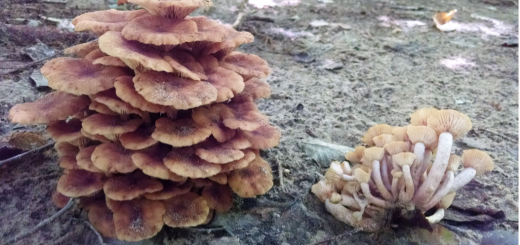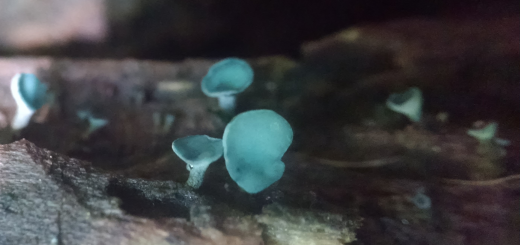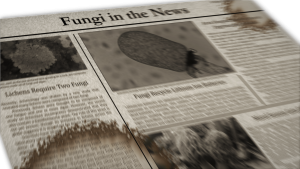#060: Urnula craterium, The Devil’s Urn
The creepiest thing about this black cup fungus is its name. Unfortunately, there’s no good story to go along with the name. If you’re a little disappointed about this, here is a story that I just made up: Some say that each mushroom holds a dead soul that has come back to haunt the world of the living. Sometimes you can even see the soul rise out of the Devil’s Urn and disappear into the air. Although this story is fictitious and tailored to fit the mood of the season, it does have some truth in it. Ascomycetes, which include cup fungi like the Devil’s Urn, often forcibly discharge their spores in a small puff when the air around them is disturbed (by, for example, picking it up or blowing on it). This helps the fungus get its spores into moving air, which can spread the spores across great distances. This fungus also goes by the names Black Tulip Fungus and Crater Cup.
True to its name, Urnula craterium is shaped like an urn or a deep goblet. Aside from the hole at the top, the mushroom is roughly shaped like a small (2-15cm), upside-down teardrop. The exterior of the mushroom is brown to dark brown and scaly at first. The interior, spore-bearing surface is black and smooth. The rim of the cup becomes torn and curled back as the mushroom matures, giving the rim a jagged appearance. Old specimens of the mushroom are often split into pieces. You can find U. craterium fruiting from the bases of logs and occasionally from buried wood. It has a particular affinity for fruiting from the areas which retain the most moisture, so look for it where logs meet the forest litter. For mushroom hunters east of the Rocky Mountains, these fungi are harbingers of morels. The Devil’s Urn is one of the first mushrooms to appear in the spring, usually just before the delicious black morels.
U. craterium is placed in the phylum Ascomycota, class Pezizomycetes, order Pezizales, and family Sarcosomataceae. This means its closest relatives are other cup fungi, morels, false morels, and elfin saddles. There are a number of both poisonous and edible fungi in this group, but the Devil’s Urn is neither. It is too tough to be considered edible, though it is apparently non-poisonous. Some people confuse this mushroom with the edible Craterellus fallax/cornucopioides (Black Trumpet chanterelles), but a close examination of the Devil’s Urn coupled with growing season (Black Trumpets only grow in the summer) should be enough to tell the two apart.
See Further:
http://www.mushroomexpert.com/urnula_craterium.html









![#011: Characteristics of Kingdom Fungi [Archived]](https://www.fungusfactfriday.com/wp-content/themes/hueman/assets/front/img/thumb-small-empty.png)


2 Responses
[…] Sarcosomataceae, which includes other large cup fungi like the Devil’s Urn, Urnula craterium (FFF#060).1,5,7 Higher up the taxonomic tree, that family belongs to the order Pezizales, which includes […]
[…] places in houses. For an example of the variety of shapes within the cup fungi, take a look at Urnula craterium, commonly known as the “Devil’s Urn.” There are many other large cups that are brown and […]